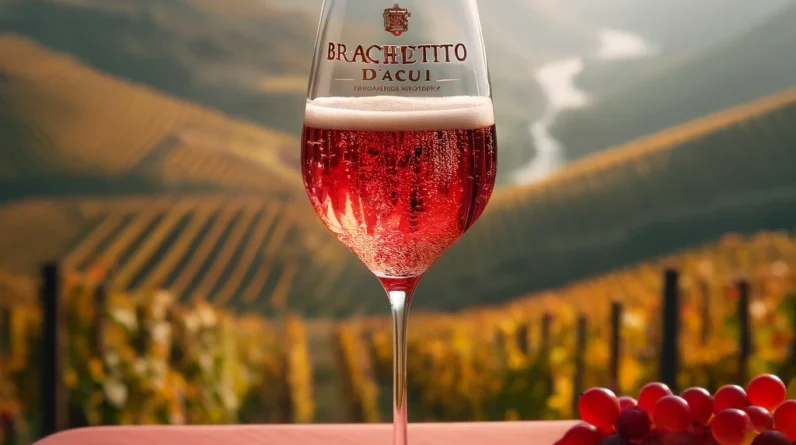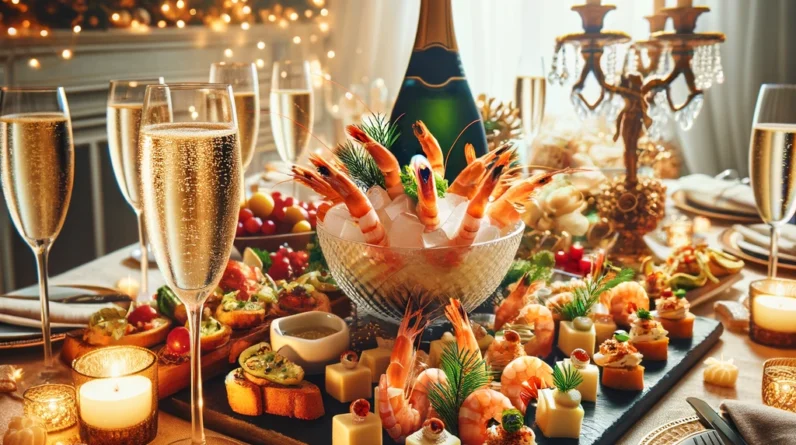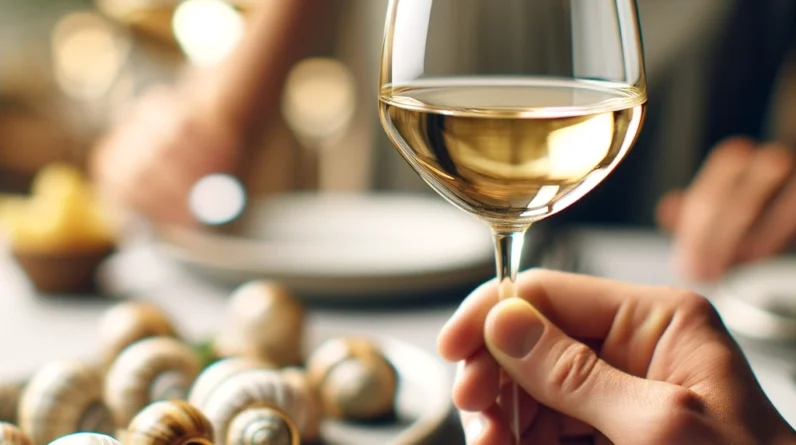
The Ultimate Guide to Escargot and Wine Pairing
Welcome to the sophisticated world of escargot and wine pairing, where the melding of flavors elevates dining to an art form.
Escargot, a celebrated French delicacy, brings a unique, buttery texture to the table, often prepared with garlic, herbs, and butter.
Finding the perfect wine to accompany this exquisite dish is key to unlocking a truly memorable gastronomic experience.
Let’s dive into the essentials of creating the perfect pairing.
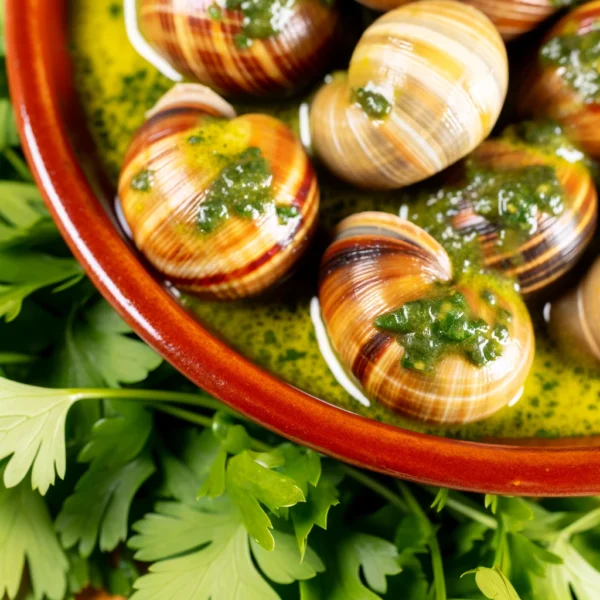
Understanding Escargot
Before diving into the pairing, let’s spotlight our key ingredient: escargot.
Escargot refers to cooked land snails, a delicacy savored for their soft, tender texture and deeply satisfying taste.
This dish is commonly prepared with a generous helping of garlic and parsley butter.
This not only adds layers of flavor but also brings a rich, creamy texture to the table.
The unique taste of escargot, combining earthy notes with the boldness of garlic and the freshness of parsley, makes it an intriguing candidate for wine pairing.
The preparation of escargot is an art in itself.
The snails are meticulously cleaned, then cooked until they reach the perfect level of tenderness.
Once prepared, they’re often served in their shells, accompanied by a savory butter sauce that’s rich with garlic and herbs.
This method of serving not only enhances the visual appeal but also heightens the eating experience, allowing the diner to savor each bite fully.
Escargot’s distinct flavor profile challenges and excites the palate.
It’s this very complexity that invites a thoughtful selection of wine.
The goal is to complement the dish’s richness without overshadowing its natural flavors.
Whether you’re a seasoned escargot enthusiast or exploring this delicacy for the first time, understanding its culinary nuances is key to unlocking a world of pairing possibilities.

The Art of Pairing Wine with Escargot
Look for Acidity
When choosing a wine for escargot, start with acidity.
The buttery richness of escargot, especially when bathed in garlic and butter, needs a wine that brings freshness to the table.
A wine with crisp acidity cuts through the creaminess, rejuvenating your taste buds.
This ensures that every mouthful of escargot feels as enjoyable as the first.
Think of acidic wines as a palate cleanser, preparing you for the next delicious bite.
Consider the Preparation
The way escargot is cooked plays a big role in your wine choice.
If your escargot is drenched in classic garlic and butter, aim for white wines.
Chablis or Sauvignon Blanc are excellent choices.
These wines have the acidity to balance the butter’s richness while harmonizing with the garlic’s punch.
Their crispness complements the dish, enhancing the flavors rather than competing with them.
Match the Intensity
Balance is key when pairing wine with escargot.
You need a wine that stands up to the dish’s rich flavors without overwhelming them.
If the wine is too light, it’ll get lost against the escargot.
On the other hand, a wine that’s too bold can overshadow the subtle qualities of the snail meat.
The trick is to find a wine that matches the intensity of the escargot.
This creates a harmonious dining experience, where the wine and escargot enhance each other’s best qualities.
In short, successful escargot pairing relies on striking the right balance between acidity, preparation, and intensity.
By considering these factors, you can select a wine that not only complements the dish but elevates the entire dining experience.
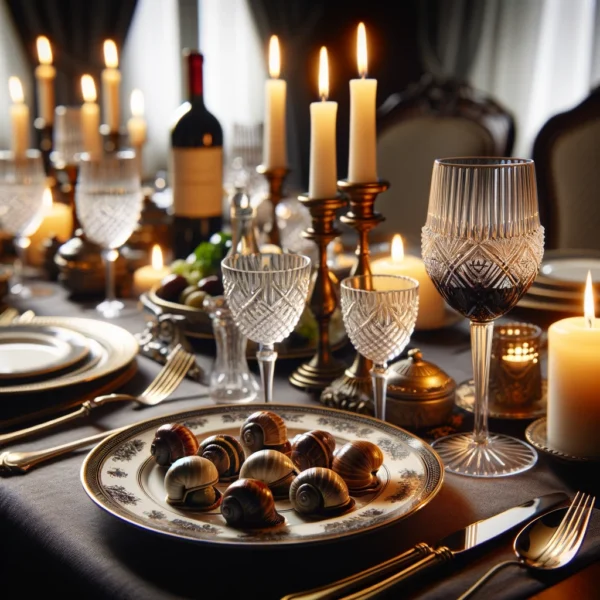
Top Wine Recommendations
Chablis: This French white wine, with its notable acidity and mineral qualities, beautifully cuts through the buttery richness of escargot.
William Fèvre Chablis Domaine: This wine is a classic example of Chablis, renowned for its crisp acidity, mineral notes, and a hint of green apple.
Its clean and sharp profile cuts through the buttery richness of escargot, balancing the dish’s flavors.
Sauvignon Blanc: Look for a zesty Sauvignon Blanc with citrus notes to complement the garlic and parsley in the dish.
Cloudy Bay Sauvignon Blanc: Hailing from New Zealand, this Sauvignon Blanc is vibrant and aromatic, with notes of lime, passionfruit, and fresh herbs.
Its lively acidity and fruit-forward character make it an excellent match for escargot, especially when the dish features garlic and parsley.
Viognier: For escargot prepared with creamier sauces, a Viognier offers a fuller body that harmonizes with the dish’s texture.
Condrieu La Doriane by E. Guigal: This Viognier from the Northern Rhône region of France is full-bodied and rich, with layers of flavors including ripe apricots, peaches, and a hint of vanilla. Its creamy texture and floral aromas complement escargot dishes that are prepared with creamier sauces, providing a harmonious blend of richness and elegance.
Pairing Insights
When choosing a wine from these specific examples, consider the style of escargot preparation you’re serving.
The key to a successful pairing is balance—allowing the wine to highlight the dish’s flavors without overpowering them. For instance:
With Garlic Butter Escargot: Opt for the William Fèvre Chablis Domaine or Cloudy Bay Sauvignon Blanc, as their acidity and crispness will enhance the garlic and butter without overwhelming the delicate taste of the snails.
With Creamier Escargot Preparations: The Condrieu La Doriane by E. Guigal, with its fuller body and aromatic complexity, pairs wonderfully, adding depth to the creaminess of the sauce without diminishing the escargot’s flavor.
Remember, the best pairings are those that bring pleasure to your palate and create a memorable dining experience.
Don’t be afraid to experiment with different wines to discover your perfect match. Cheers to exploring the delightful synergy between escargot and wine!

Creating the Experience
Pairing escargot with wine goes beyond just matching flavors.
It’s about crafting a memorable experience.
The environment, how the dish looks, and the way you serve the wine all play a part in this culinary journey.
Set the Scene
The ambiance matters. Whether it’s a candlelit dinner or a cozy gathering with friends, the setting can transform your meal into an occasion.
Soft lighting and elegant tableware can add a sense of sophistication and anticipation.
Focus on Presentation
How you present the escargot is crucial.
Serving it in traditional escargot dishes not only looks charming but also adds authenticity to the experience.
It shows attention to detail and respect for the dish’s heritage.
Choose the Right Glassware
Using the correct glassware for your wine elevates the act of drinking it.
Different shapes can enhance various aspects of the wine, such as its aroma, taste, and overall drinking pleasure.
A well-chosen glass makes each sip a discovery.
Check out this awesome glassware here!
Serve the Wine Thoughtfully
How and when you serve the wine can heighten the dining experience.
Pour the wine just before serving the escargot to capture its aroma and flavor at their peak.
Ensure the wine is at the right temperature to fully appreciate its character.
Looking for a quality decanter?
Create a Connection
Encourage conversation about the wine and escargot pairing.
Discussing the flavors and the pairing choices can enrich the experience, making it more engaging and memorable for everyone involved.
In essence, the art of pairing escargot with wine is about more than just taste—it’s about creating moments that linger in the memory, enhanced by thoughtful details and shared enjoyment.
Embarking on the journey of escargot and wine pairing opens up a world of culinary delight, blending the rich flavors of a timeless delicacy with the refined nuances of wine.
By understanding the principles of pairing, you can transform a simple meal into an extraordinary experience.
Remember, the best pairing is one that brings joy to your palate and leaves you eagerly anticipating the next bite. Cheers to your culinary adventure!
| # | Wine Suggestion | Escargot Dish Type | Reason for Pairing | Price Range | Glassware | Serving Temperature |
|---|---|---|---|---|---|---|
| 1 | William Fèvre Chablis Domaine | Classic garlic and butter | Crisp acidity and mineral qualities cut through buttery richness.
| $25-$50 | Chablis glass | 45-50°F (7-10°C) |
| 2 | Cloudy Bay Sauvignon Blanc | Garlic and parsley butter | Vibrant acidity and fruit-forward character complement garlic and parsley.
| $20-$40 | Sauvignon Blanc glass | 46-50°F (8-10°C) |
| 3 | Condrieu La Doriane by E. Guigal | Creamier sauces | Fuller body harmonizes with creamier textures, adding depth.
| $50-$100 | Viognier glass | 50-54°F (10-12°C) |
| 4 | Pinot Noir (Light-bodied) | Tomato-based or red wine reduction | Light body and fruity notes can complement without overpowering.
| $15-$30 | Burgundy glass | 55-60°F (13-15°C) |
| 5 | Riesling (Higher Acidity) | Salty or savory dishes | Sweetness balances saltiness, with acidity cutting through richness.
| $10-$25 | White wine glass | 46-50°F (8-10°C) |
| 6 | Champagne/Prosecco (Sparkling) | Any type, especially rich and buttery | Effervescence and acidity refresh the palate against rich dishes.
| $30-$60 | Flute or tulip | 42-46°F (6-8°C) |
| 7 | Joseph Drouhin Pouilly-Fuissé | Herb-heavy dishes | Elegant, with a balance of fruit and acidity to complement herbs.
| $20-$45 | White wine glass | 48-52°F (9-11°C) |
| 8 | Kim Crawford Pinot Gris | Lightly spiced dishes | Fruity notes with a hint of sweetness to balance spice.
| $15-$25 | Pinot Gris glass | 46-50°F (8-10°C) |
| 9 | Robert Mondavi Fumé Blanc | Garlic-heavy preparations | Crisp acidity to cut through garlic richness.
| $18-$35 | Sauvignon Blanc glass | 46-50°F (8-10°C) |
| 10 | Beringer Private Reserve Chardonnay | Rich, creamy sauces | Rich and oaky to match the sauce’s texture.
| $30-$50 | Chardonnay glass | 48-54°F (9-12°C) |
| 11 | Domaine Zind-Humbrecht Gewürztraminer | Spicy or aromatic dishes | Floral and spicy notes to pair with aromatic spices.
| $25-$60 | Gewürztraminer glass | 46-54°F (8-12°C) |
| 12 | Louis Roederer Brut Premier Champagne | Celebratory or rich dishes | Fine bubbles and acidity to cut through richness, adding a festive touch.
| $40-$70 | Champagne flute | 45-48°F (7-9°C) |
FAQs:
Q1: Can I pair red wine with escargot?
A1: While white wines are traditionally recommended due to their acidity and ability to complement the buttery richness of escargot, lighter red wines with lower tannin levels can also be paired.
Pinot Noir, with its light body and fruity notes, can complement escargot, especially when served with a tomato-based or red wine reduction sauce.
Q2: What if I prefer sweet wines?
A2: Sweet wines are typically challenging to pair with escargot due to the dish’s savory profile.
However, if you enjoy sweeter wines, opt for those with higher acidity to balance the sweetness, such as a Riesling.
Its sweetness can counterbalance the saltiness of the dish, but it’s crucial to ensure the wine’s acidity can cut through the richness.
Q3: How important is the wine’s temperature when pairing with escargot?
A3: Serving temperature is crucial for both wine and escargot.
White wines should be chilled but not too cold, ideally between 50-60°F (10-15°C), to enhance their aromatic profile and acidity.
This temperature range ensures that the wine complements the escargot without overpowering it.
Q4: Can I use the same wine in the cooking process as I serve for pairing?
A4: Absolutely! Using the same wine for cooking and serving can create a harmonious flavor profile, enhancing the overall dining experience.
This approach ensures that the wine’s characteristics are well integrated into the dish, making the pairing more seamless.
Q5: Are there any non-alcoholic alternatives that pair well with escargot?
A5: For those preferring a non-alcoholic option, look for beverages with a balance of acidity and complexity, such as sparkling mineral water with a squeeze of lemon or lime, or non-alcoholic sparkling wines.
These can mimic the refreshing quality of white wine, cleansing the palate between bites.
Q6: How do I choose a wine if my escargot dish has unique ingredients or spices?
A6: For escargot dishes with unique ingredients or bold spices, focus on wines that match the intensity of the flavors.
Spicy or aromatic dishes may benefit from aromatic whites like Gewürztraminer or Torrontés, which can complement the spices without competing with them.
Q7: Is it necessary to spend a lot on wine for a good pairing with escargot?
A7: Not at all. While high-quality wines can enhance the pairing experience, there are many affordable options that also pair wonderfully with escargot.
Focus on the wine’s characteristics—acidity, body, and flavor profile—rather than its price tag.
Experimenting with different wines within your budget can lead to delightful discoveries.
Q8: Can I pair escargot with sparkling wines?
A8: Yes, sparkling wines like Champagne or Prosecco can be excellent choices for pairing with escargot.
Their effervescence and acidity can cut through the richness of the dish, adding a refreshing contrast and elevating the dining experience.






